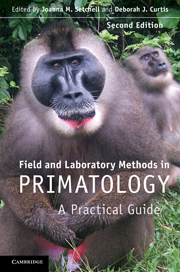Book contents
- Frontmatter
- Contents
- List of contributors
- Foreword by Robert D. Martin
- Introduction
- 1 An ethnoprimatological approach to interactions between human and non-human primates
- 2 Habituating primates: processes, techniques, variables and ethics
- 3 Habitat description and phenology
- 4 Geographical information systems and remote sensing
- 5 Monitoring local weather and climate
- 6 Survey and census methods: population distribution and density
- 7 Trapping primates
- 8 Handling, anaesthesia, health evaluation and biological sampling
- 9 Morphology, morphometrics and taxonomy
- 10 Marking and radio-tracking primates
- 11 Field experiments with non-human primates: a tutorial
- 12 Feeding ecology, frugivory and seed dispersal
- 13 Dietary analysis I: food physics
- 14 Dietary analysis II: food chemistry
- 15 Collecting arthropods and arthropod remains for primate studies
- 16 Recording primate vocalizations
- 17 Photography and video for field researchers
- 18 Chronobiological aspects of primate research
- 19 Thermoregulation and energetics
- 20 Field endocrinology: monitoring hormonal changes in free-ranging primates
- 21 Collection, storage and analysis of non-invasive genetic material in primate biology
- 22 Tips from the bush: an A–Z of suggestions for successful fieldwork
- Index
- References
1 - An ethnoprimatological approach to interactions between human and non-human primates
Published online by Cambridge University Press: 05 June 2012
- Frontmatter
- Contents
- List of contributors
- Foreword by Robert D. Martin
- Introduction
- 1 An ethnoprimatological approach to interactions between human and non-human primates
- 2 Habituating primates: processes, techniques, variables and ethics
- 3 Habitat description and phenology
- 4 Geographical information systems and remote sensing
- 5 Monitoring local weather and climate
- 6 Survey and census methods: population distribution and density
- 7 Trapping primates
- 8 Handling, anaesthesia, health evaluation and biological sampling
- 9 Morphology, morphometrics and taxonomy
- 10 Marking and radio-tracking primates
- 11 Field experiments with non-human primates: a tutorial
- 12 Feeding ecology, frugivory and seed dispersal
- 13 Dietary analysis I: food physics
- 14 Dietary analysis II: food chemistry
- 15 Collecting arthropods and arthropod remains for primate studies
- 16 Recording primate vocalizations
- 17 Photography and video for field researchers
- 18 Chronobiological aspects of primate research
- 19 Thermoregulation and energetics
- 20 Field endocrinology: monitoring hormonal changes in free-ranging primates
- 21 Collection, storage and analysis of non-invasive genetic material in primate biology
- 22 Tips from the bush: an A–Z of suggestions for successful fieldwork
- Index
- References
Summary
AN ETHNOPRIMATOLOGICAL DIMENSION
Twenty years ago it was generally considered unthinkable (as well as unfundable and unpublishable) to carry out research on non-human primates (hereafter ‘primates’) that were in contact with human populations. Such contexts were seen as abnormal/aberrant situations, which distorted ‘natural’ primate behaviour and ecology. In the last decade this bias has gradually yielded to an appreciation that the human–primate interface is not only a legitimate area of research, it is an area of critical importance to both primate conservation and human health. In fact, as human encroachment on primate habitat squeezes the remaining populations of wild primates into ever shrinking areas, the human–primate interface increasingly represents the rule, rather than the exception, of interspecies interaction.
Ethnoprimatology refers to the study of the ecological and cultural interconnections between humans and primates. In a sense, all research on primates, from behavioural studies on free-ranging animals to research on laboratory-based primates, has an ethnoprimatological dimension. This is at least in part because our own cultures so completely colour every aspect of how and why we carry out our scientific inquiry. Additionally, culture, as it relates to the economic, social and political structures of society, profoundly influences how people living in habitat countries interact with and respond to primates.
- Type
- Chapter
- Information
- Field and Laboratory Methods in PrimatologyA Practical Guide, pp. 21 - 32Publisher: Cambridge University PressPrint publication year: 2011
References
- 5
- Cited by



